Making the transition from kelp to lamp: the research on forming a design process model for cultural creative products
Abstract
The policy of cultural creative industries is regarded as an important contributor to accelerate economic growth and employment creation in Taiwan. Developing cultural creative products is crucial for expressing cultural values, establishing brand images, and creating business value. This study proposes a novel design process model for developing cultural creative products, which was tested and applied via a realistic case study, i.e. designing a lamp from kelp. The case study was conducted through a practice-based research approach, i.e. research through design (Schneider, 2007). A series of workshops were carefully organised to form a structured design decision-making process for conducting the case study, in which 31 novice designers as participants had to make critical decisions in the end of every workshop. Three different data collection methods were simultaneously applied during the workshops: observation, research diary, and interviews. It was demonstrated that the proposed design process model could facilitate the efficiency of design project and guide the participants to being identifying and using proper design methods to deal with different design issues in different phases. The study's outcomes indicate the effectiveness of the design process model, making it a valuable reference for developing various types of cultural creative products.
Keywords
Cultural creative product, Design process model, Research through design
1. Introduction
In response to the challenges posed by global competition and the knowledge economy, Taiwanese industries, which were previously focused on original equipment manufacturing (OEM) and original design manufacturing (ODM), are currently undergoing a significant transformation by shifting their focus towards brand development and embracing creative design. The concept of the cultural creative industry has emerged as a pivotal strategy for industrial upgrading and transformation, driven by the shared consensus and expectations of the government, academia, and industry. Moreover, it is also seen by industries as a good approach to increase profit and pursue innovation.
Taiwan's cultural creative industry gained momentum with the launch of the "Challenge 2008: National Development Priority Program" initiated by the Executive Yuan in 2002. Despite occasional criticisms surrounding the broad definition of the cultural creative industry in the past, its undeniable success and prosperity across various sectors throughout Taiwan have proven its significant contribution to the economy. In recent years, there has been a remarkable proliferation of cultural creative industry parks, tourism factories, cultural creative stores, and companies across the country, serving as tangible evidence of the cultural creative industry's positive impact on Taiwan's economic vitality.
Therefore, numerous new products are launched into the related markets. While there has been extensive research on the design process and methods of cultural creative products (Fan, 2004; Hsu, 2005; Liu et al., 2006; Chan and Lee, 2008; Tung, 2011; Wang and Hung, 2011; Wei, 2011; Hsu and Lin, 2011; Chen and Chen, 2014; Lin, 2015; Hsiao, 2016; Chen, 2017; Chuang, 2018; Wang and Chiou, 2019; Zhu and Han, 2022; Kang and Nagasawa, 2023), there has been a lack of efforts to integrate design management frameworks that incorporate image transformation methods for cultural creative product design. Thus, this study develops a novel design process model for cultural creative products, testing and applying this design process model via a realistic case study, i.e. designing a lamp from kelp. The case study was conducted via a practice-based research approach, i.e. research through design (Frayling, 1994; Schneider, 2007). A series of workshops were carefully organised to create a structured design process to conduct the case study.
2. Literature review
2.1. Design innovation and emotional value
To thrive or even survive in today’s competitive world, it is critical to nurture and develop innovation capabilities. Design plays a significant and important role to the creation of an innovative product (HMSO, 1995; Berends et al., 2010; Lee, 2015). A cultural creative product can be defined as an outcome of design activities in which cultural resources and elements are creatively and strategically utilised and transformed into new products (Lee, 2018). The primary purpose of developing a cultural creative product is very similar with developing any other new product, i.e. producing a competitive, innovative, and profitable new product. Product differentiation is a good strategy to fulfil the purpose (Gebauer et al., 2011). It is an effective approach to distinguish a product from its competitors on one or more basic performance or image features (Sharp and Dawes, 2001; Dickson, 1997).
However, to achieve product differentiation in today’s competitive markets is difficult, especially in cultural creative markets. Merely investing effort in the forms or functions of products is no longer sufficient in today's consumer landscape, as consumers have become more demanding than ever before. Consumers are no longer satisfied with products that simply offer reasonable prices and good quality; they are also actively seeking products that provide emotional value. Products that can evoke positive and memorable experiences have become increasingly popular (Norman, 2004). Moreover, product has connections with cultures, community and environment could produce more emotional value to users and consumers (Hsu and Lin, 2011; Chen, 2017). We may say that embedding cultural connections in product design process is one of the important differentiated strategies in today’s competitive marketplace.
It is evident that placing emphasis on emotional connection (Norman, 2004; Suen, 2008; Lee, 2022), emotional benefits (Barrena et al., 2009), or emotional value (Desmet et al., 2001) may offer a more viable and practical approach for product differentiation within the cultural creative product industry. Furthermore, imitating the emotional characteristics of a cultural creative product is not as straightforward as replicating its forms and functions. Creating an authentic and compelling narrative that resonates with the target audience is crucial in this endeavour. For instance, incorporating storytelling is an effective approach to embed emotional features into a product (Chiou, 2017). The unique experience generated by a compelling narrative behind a product is not easily imitated.
Norman (2004) asserts that the reactions of users to design can be divided into three experience levels: visceral, behavioural, and reflective (see Figure 1). Visceral level experience in design is related to intuition. It is an immediate powerful reaction to a design and “includes the basic perceptual tasks of distinguishing objects and forming our true first impressions” (Bennett et al., 2007). The behavioural level is experienced during the use of a design. It builds upon output from the visceral level, and “focuses on issues such as readability and usability” (Bennett et al., 2007). The reflective level refers to the higher levels of emotion and cognition. Design in this area is usually focus on analytic and cognitive skills, as Norman (2004) said: “It represents an attempt to make a design better by incorporating the experience of users and their knowledge of goals and objectives of the product or service”. Reimann (2005) asserted that when the design of a product or service addresses users' goals and motivations, goes beyond its primary purpose, and taps into personal or cultural associations, reflective meaning can be created. To develop products with added emotional value, it is essential to employ the three design strategies identified by Norman (2004).
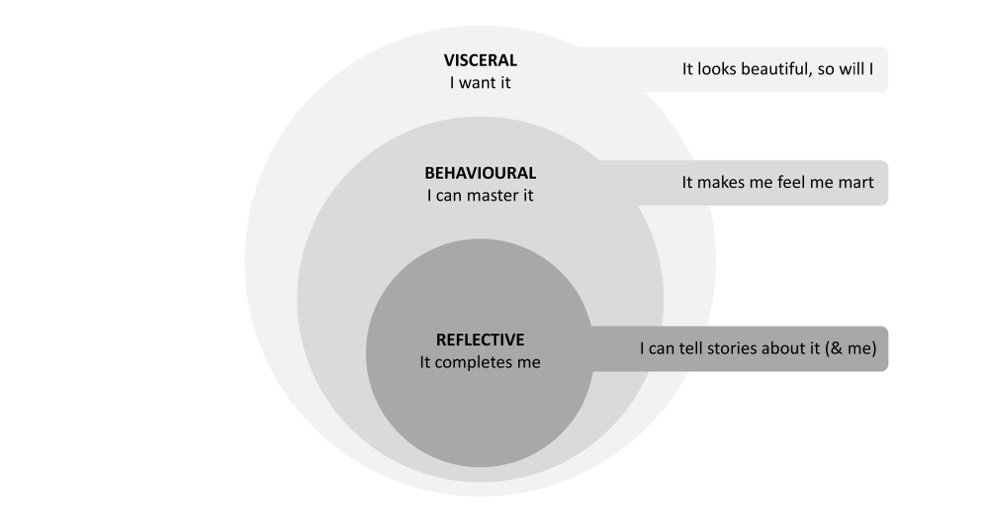
Based on the innovation driven approach, product innovation can be categorised as two types: technology-push innovation and Market-pull innovation (Clark & Guy, 1998; Verganti, 2008). In the design research field, there is another approach called “design driven innovation”, “design-led innovation”, “design inspired innovation”, or “design innovation”, in which concepts of new products stem from design thinking, or the design process, or the newness of new product development outcomes based on a design perspective (Cantarello et al., 2011; Rampino, 2011; Lee, 2015). Design driven innovation can be categorised into four levels (Rampino, 2011) (see Figure 2):
- Aesthetic Innovation: is related to product recognition, i.e. to how much a product’s appearance differs from that of the competitors’ products.
- Innovation of use: involves the degree to which a product improves or modifies its usage, perhaps adding new functions, as compared to products already on the market.
- Meaning innovation: concerns the emotional and symbolic aspects of a product, i.e. what a product is able to communicate.
- Typological innovation: relates to the deviation of a product from its formal archetype, i.e. a dominant design.
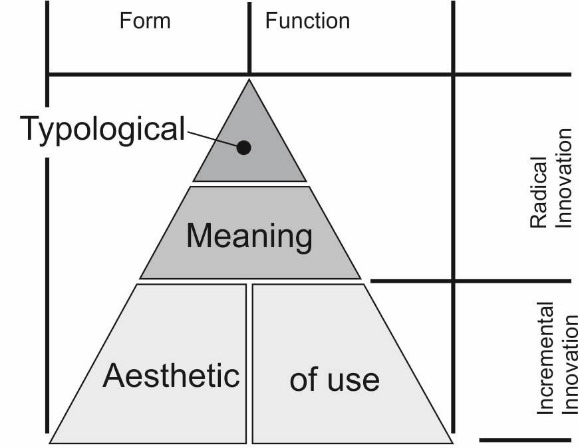
In Rampino’s (2011) innovation pyramid, typological innovation means a dominant design which is a product’s basic architecture that has become the accepted market standard in a specific product category (Abernathy & Utterback, 1978), e.g. Apple’s ipad and iphone. It is interesting that Norman’s (2004) three design strategies for pursuing emotional value could be well integrated with and Rampino’s (2011) theory of innovation pyramid if we only look at the other three design innovation (see Figure 3). The two theories both insist on the importance of meaning in the process of experiencing products, i.e. giving reflective emotional level experience a high degree of opinion. To achieve the high level of emotional value, or design innovation, requires carefully developing products’ visual aesthetics and creativity of use. This is the key to sustainable success for cultural creative products.
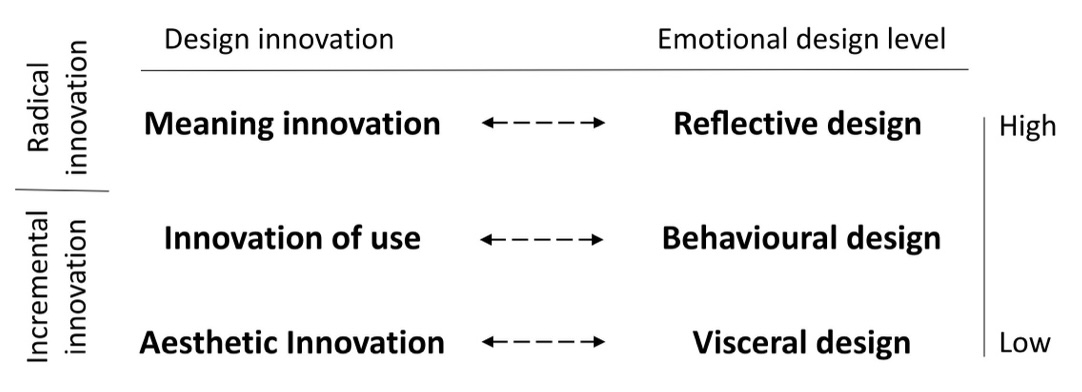
2.2. Forming a design process model for cultural creative products
Since the promotion of Taiwan's cultural creative industries policy in 2002, there has been a growing need to design and develop cultural creative products quickly and effectively. Thus, scholars have put forth a variety of design models and approaches for designing cultural creative products (Fan, 2004; Hsu, 2005; Liu et al., 2006; Chen and Lee, 2008; Tung, 2011; Wang and Hung, 2011; Wei, 2011; Hsu and Lin, 2011; Chen and Chen, 2014; Lin, 2015; Hsiao, 2016; Chen, 2017; Wang and Chiou, 2019; Zhu and Han, 2022; Kang and Nagasawa, 2023). It is worth noting that several models (Fan, 2004; Shiu, 2005; Chen et al., 2012; Lin, 2015; Shiao, 2016; Chen, 2017) have been developed based on the concept of image transformation design process proposed by You et al. (1996), which itself draws on product semantics theories. You et al.'s (1996) design process consists of three steps: association, transformation, and implementation (see Figure 4).

This design process model emphasises the transformation of abstract concepts into symbolic images and then into realistic product forms, which closely aligns with the concept of designing a cultural creative product. It involves creative and strategic utilisation of cultural resources and elements to create innovative and unique products. Furthermore, this approach also recognises the significance of incorporating emotional value into the design process, ensuring that the resulting cultural creative products evoke meaningful and impactful experiences for consumers. This study recognises that the theoretical framework proposed by You et al. (1996) has clear objectives and is user-friendly. Additionally, it considers that its fundamental core values align with the essence of cultural creative products, which involve creatively and strategically transforming cultural elements and resources into symbolic expressions through product forms or usage contexts. Therefore, this study adopts the design process of transforming conceptual images into tangible symbols, as proposed by You et al. (1996), as the basic theoretical framework for the design process model of cultural creative products.
Design is a carrier of innovation by which creativity may occur during the design process. Aristizabal (2012) states that divergent and convergent thinking skills are both important aspects to creativity. According to Lee (2015), divergent and convergent thinking are adopted interchangeably during design process. Dundon (2002) argues that the key to a successful innovation project lies in alternating between convergent and divergent thinking during the process. You et al.’s (1996) design process model lacks a mechanism to manage divergent and convergent thinking. The British Design Council (2006) proposed a design process based on in-house research which studying eleven leading companies, i.e. the double diamond design process model (see Figure 5). The model is divided into four distinct phases, Discover, Define, Develop and Deliver. It presents the divergent and convergent nature of the stages in the design process. In the discover and develop stages, the design team would attempt to find opportunities and solutions as soon as possible while deciding which solution should be progressed and focusing on problem-solving in the define and deliver stages. You et al.’s (1996) three steps stage design process does not explicitly address the concept of creative thinking models. On the other hand, the theoretical concept of the double diamond model provides a framework that guides the integration and interaction of divergent and convergent thinking throughout the design process. This study believes that these two methods can complement each other and be integrated and applied together.
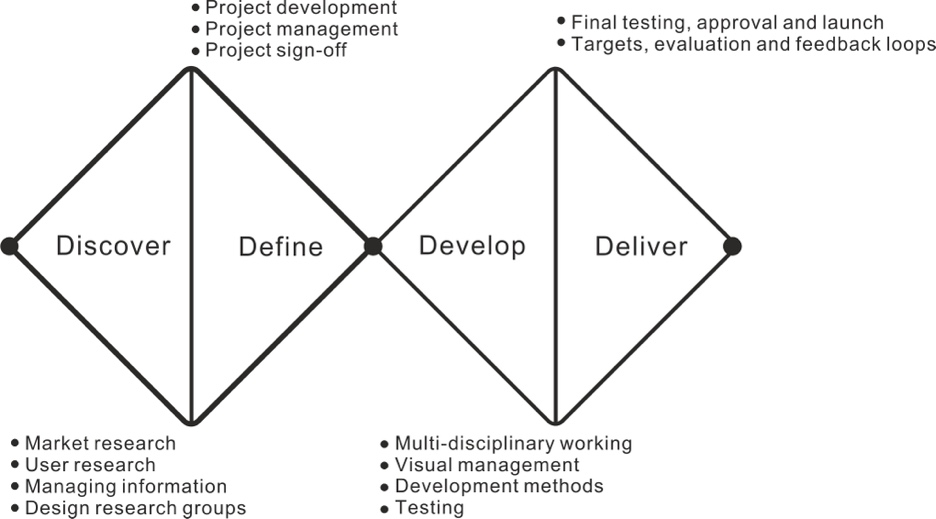
To develop a successful new cultural creative product is not a singular event but a process in which a series of activities are linked, providing a framework for controlling chaos without precisely dictating each step (Gaynor, 2002; Trott, 2005; Vogel et al., 2005). While the three steps design process proposed by You et al.’s (1996) is logically clear, easy to understand, and offers practical value, its theoretical framework does not provide sufficient guidance to facilitate decisions for improving design teams’ operation. Lee (2015) asserts that the key to achieving successful innovation is to identify critical design decision-making points and manage the design process effectively. Building upon this perspective, it is important to note that effective management of the design process requires a systematic and well-defined approach. Roger G. Cooper (2000) proposed an extensively accepted model for new product design, namely, the stage-gate process (see Figure 6). Stage is the activities of design, and gate plays a guard rule to judge and evaluate the result of front stage is whether good enough to move to next stage. Gate severs as the quality control and Go/Kill check point in the process. This study believes that the concept of the stage-gate model can be integrated into the design process of transforming imagery proposed by You et al. (1996), providing a framework for critical design decision points to enhance design quality, project execution efficiency, and decision effectiveness.

As mentioned above, the three design processes have been proven to be practical and effective, and their respective advantages and characteristics can be integrated into one. Therefore, this study proposes a design process model framework specifically for the development of cultural creative products (see Figure 7). This design process model is based on the design method of transforming imagery into representations proposed by You et al. (1996), incorporating the concept of critical decision points from Cooper (2000)'s stage-gate model, and integrating the framework of divergent and convergent thinking from The British Design Council's (2006) double diamond design process.
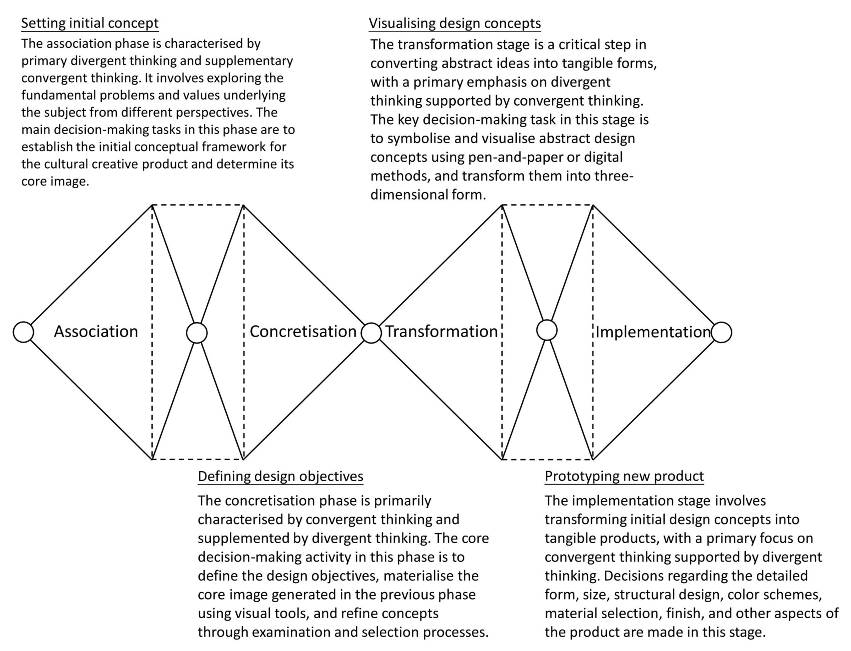
The proposed design process model for the development of cultural creative products consists of four stages, and the details are as follows:
(1) Association: setting initial concept
Association is primarily the description or presentation of ideas, experiences, concepts, memories, and perceptions related to the theme from one's inner thoughts (You et al., 1996). It is a stage characterised by divergent thinking as the main approach, supplemented by convergent thinking. During this stage, the design team engages in different perspectives and examines the fundamental problems and values behind the theme. By utilising associative techniques, they generate relevant concepts and creative ideas.
The primary decision-making task during this stage is to establish the framework for the initial concept of the cultural creative product and decide on the core imagery. The team taps into their inner thoughts to describe and present ideas, experiences, concepts, memories, and perceptions related to the theme, i.e. reflecting available cultural resources. By employing associative techniques, they generate relevant concepts and creative ideas. This process sets the foundation for subsequent stages, where the selected concept will be further developed and refined.
(2) Concretisation: defining design objectives
The concretisation stage, primarily driven by convergent thinking and supported by divergent thinking, focuses on visualising and materialising abstract concepts. The core decision-making activity in this stage is defining design goals by using visual tools such as mood boards and image positioning maps. These tools help to depict, describe, and exemplify the core imagery generated in the previous stage. Through a process of review and selection, the core imagery is refined during this stage.
The use of more tangible media, such as collage techniques with images, aids in visualising and concretising the concept that was previously described in words. This stage brings clarity and concreteness to the abstract concepts through visual representation. It enables the design team to create a more tangible and visual understanding of the core imagery. By defining design goals and materialising them through visual tools, the concretisation stage bridges the gap between abstract ideas and tangible design objectives. It provides a clearer direction for the design process and facilitates effective communication among team members, stakeholders, and potential users.
(3) Transformation: visualising design concepts
The transformation stage is a key step in the design process where abstract concepts and visual imagery are translated into concrete symbols and product forms (You et al., 1996). It is primarily driven by divergent thinking, supplemented by convergent thinking. During this stage, the core concepts and visual imagery generated in the previous stages are symbolised or simplified to represent the design theme. These representations are then further developed and transformed into three-dimensional forms. The transformation stage is often referred to as the "black box" because the creative or inspirational sources behind the design ideas are not always identifiable or documented (Kurtoglu et al., 2010). The main decision task in this stage is to visually represent the abstract design concepts from designers’ minds using pen and paper or digital methods.
In the transformation stage, the visualisations created act as a powerful medium for designers to explore and experiment with diverse shapes, proportions, and material combinations, refining their concepts through valuable visual feedback. This iterative process allows designers to simulate and comprehend how users will perceive and experience the product. Crucial decisions concerning the feasibility and aesthetic value of the product concept are often made during this stage, underscoring the significance of its efficiency and effectiveness in driving the design progress. Transforming abstract concepts into concrete solutions entails not only creative ideation and the application of manufacturing knowledge but also demands a deep understanding of the existing market conditions and the needs and expectations of users. This holistic approach ensures that the final design solution seamlessly aligns with the requirements of users, the market, sales channels, and manufacturing processes.
(4) Implementation: prototyping new product
Implementation involves the process of concretising or commercialising the design concept (You et al., 1996), which is the final phase of the proposed design model for cultural creative products. This stage focuses on transforming the preliminary visualised design concept into a tangible product or prototype. Convergent thinking is primarily employed, supported by divergent thinking, to execute and materialise the design ideas. A prototype is a refined model of the product that is developed before mass production or commercialisation. Its purpose is to evaluate and test the product's quality, examine the possibility of simplifying components, assess the rationality of component assembly, estimate production costs, conduct functional testing, prepare product catalogues in advance, participate in exhibitions, or engage in discussions with clients to secure orders. The series of actions involved in prototype development is commonly referred to as prototyping.
During the prototyping process, numerous design decisions need to be made, considering various aspects of the product. Design details such as the product's form, size, structure, colour combinations, material selection, and surface treatments are finalised in this stage. Additionally, considerations related to the production of the product may also need to be addressed during this phase. The implementation stage is critical for ensuring that the design concepts are successfully transformed into tangible products that meet the desired objectives. It involves refining the design, addressing production considerations, and creating a prototype that accurately represents the intended final product. This stage sets the foundation for subsequent steps such as production, marketing, and commercialisation of the cultural creative product.
Throughout the design process, key decision points are strategically placed to evaluate the progress, feasibility, and alignment with project objectives. These decision points serve as gates to assess the readiness of moving to the next stage and ensure the effective allocation of resources. By integrating the imagery transformation design method, the stage-gate model, and the divergent-convergent thinking framework, this proposed design process model provides a comprehensive and systematic approach for cultural creative product development, fostering innovation, efficiency, and decision-making effectiveness throughout the entire process.
3. Methodology
This study adopts a research through design approach (Frayling, 1994; Zimmerman et al., 2007) to conduct a practical research project aimed at implementing and validating the proposed design process model. The research method primarily consists of literature review and case study. The literature review focuses on the integration and establishment of design models for cultural creative product design, as well as the relationship between design innovation, emotional value, and cultural creative products. The case study in this research is conducted through the practical implementation of the Oceanic Cultural Creative Product Design course in the Bachelor Degree Program in Oceanic Cultural Creative Design Industries at National Taiwan Ocean University (see Figure 8).
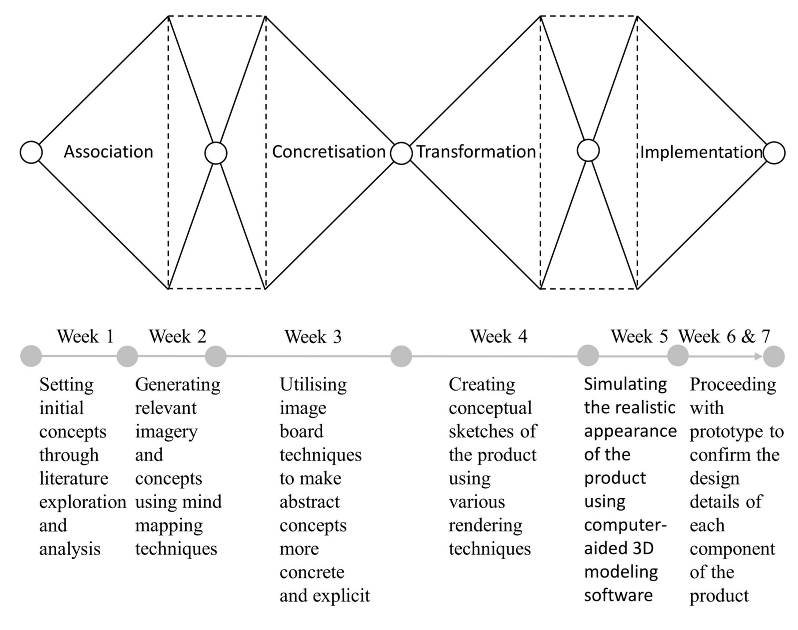
A seven-week design practical project was conducted in the form of workshops. The study aims to understand participants' experiences, perceptions, and reflections on implementing the proposed design process model and to explore related issues in developing this design process model. A total of 31 novice designers participated in the workshop and collaborated on designing and developing cultural creative products. The workshops, based on the design process model proposed in this study, spanned seven weeks with two hours per week, corresponding to the four stages of the design process, each with specific tasks and requiring participants to make different key decisions.
Data collection methods included various forms of visual records during the workshops, documentation of paper-based and digital materials produced in each stage, observation of participants' design behaviours, research diary documenting the researcher's reflections, utilisation of semi-structured questionnaires for post-project interviews, and analysing the interview data and other relevant materials using content analysis. The triangulation method was used to objectively analyse the data and ensure its reliability and validity. Continuous reflection and revision were conducted throughout the process.
4. Case study: making the transition from kelp to lamp
In recent years, the government has made significant efforts to promote the cultural creative industries in Taiwan. Apart from seeking alternative paths to overcome the low-profit predicament of the manufacturing industries, enhancing the aesthetic quality of people's lives is another key aim. In the contemporary global aesthetic trend, lifestyle aesthetics and environmental aesthetics are closely interconnected. Discussing lifestyle aesthetics cannot be separated from the environmental factors we inhabit (Liu, 2010). However, despite Taiwan's strong connection to the ocean and its proud magnificent coastal landscapes, there are few cultural creative products that incorporate marine imagery available in the markets. Therefore, integrating maritime imagery into the design of cultural creative products can not only fill the gap in the market but also highlight Taiwan's unique marine culture and resource advantages, providing consumers with more diverse, interesting, and emotionally resonant product choices.
This study takes the design of a series of cultural creative products with marine imagery as the case study to validate the feasibility of the proposed design process model. In this section, the actual development of the new product project will be described in concrete detail. Based on this research framework, the study carefully organised a series of workshops corresponding to the four major stages in the proposed design process model, in which 31 novice designers, all second-year students from the National Taiwan Ocean University, participated. The assignment given to the design team was to “develop a series of cultural creative products inspired from kelp and ocean”. Additionally, the results of the new product development project would be used in a small kelp museum for the purpose of public education.
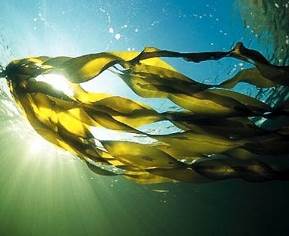
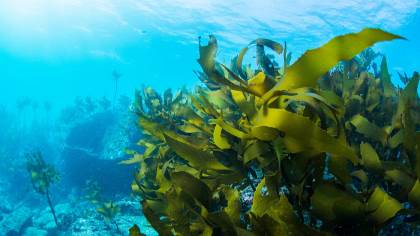
4.1. Association stage: setting initial concept
4.1.1. Symbolising marine imagery to evoke environmental sustainability
Taiwan is surrounded by the sea, and its culture is deeply influenced by its maritime heritage. Whether it's the rich history, diverse geography, religious traditions, or culinary delights, Taiwan maintains a profound connection to its oceanic surroundings. The relationship between Taiwan and the ocean spans centuries, from the indigenous tribes who have inhabited the islands for generations to the coastal immigrants from mainland China who bravely crossed the treacherous waters of the Taiwan Strait over the past few centuries. The ocean has always been intertwined with the lives of the Taiwanese people, flowing through their veins.
The ocean has generously provided Taiwan with abundant natural resources, contributing to its prosperity. Literature and poetry often exalt the vitality of the ocean, comparing it to a nurturing mother. However, in recent decades, the ocean, which should be our closest ally, has fallen victim to the pursuit of economic development. The ecological environment of Taiwan's seas has suffered significant damage, a widely recognised fact. What is disheartening is that this destruction persists in the present, extending beyond the past.
A prominent example is the case of the deteriorating algae reef along the coast of Datan in Taoyuan (see Figure 10). Despite the collective efforts of scholars and environmental organisations to raise awareness about the detrimental impact of CPC Corporation's third liquefied natural gas receiving station on the reef and its ecosystem, the project continues. Furthermore, many local coastal residents, perhaps accustomed to receiving compensation, remain indifferent to the controversy surrounding the development of the natural gas receiving station (Lam, 2018). This highlights the lack of public awareness in Taiwan regarding ocean preservation and underscores the significance of marine education.
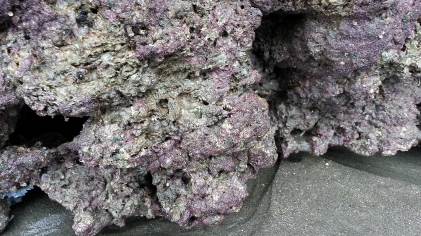
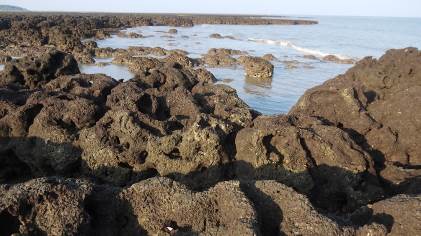
Clearly, greater efforts are needed in marine conservation education. Although the Taiwanese government launched "An Overview on the Ministry of Education's Marine Education Policies" in 2012 to enhance the public's ocean consciousness, many Taiwanese individuals are still unaware of the importance of maintaining a sustainable ocean environment. Promoting marine education should not solely be the responsibility of the government, but a duty shared by all citizens. Therefore, our design team aims to contribute by developing a new product adorned with symbolic marine imagery, which can prompt users to reflect on ocean sustainability issues in their daily lives when using the product.
4.1.2. Developing a table lamp using kelp as material
Kelp, also known as algae or seaweed, occupies a significant place in Taiwan's culinary culture, being perceived as healthy, delicious, and affordable (see Figure 11). In the very beginning stages of the project, the design team utilised free association and conducted data collection to explore innovative opportunities and generate initial ideas. This divergent thinking phase involved gathering as much relevant information as possible, which helped establish the initial framework for the new product. This phase involves gathering diverse inputs that would later contribute to the subsequent convergent stage.
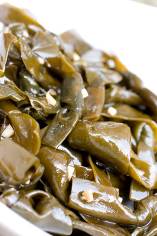
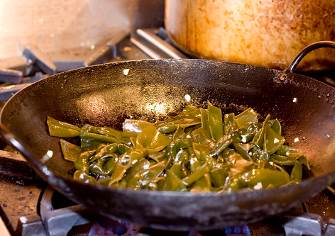
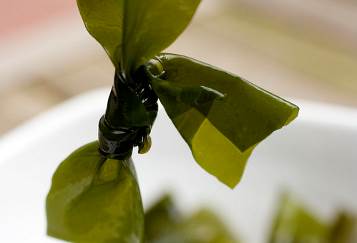

During this phase, the design team discovered a conceptual connection between kelp and sunlight, symbolising ideas of health and vitality. Consequently, they decided to develop a table lamp that incorporates kelp as a prominent material or component. The goal is to evoke or subtly instill sustainability awareness through the lamp's distinctive appearance and the interaction mechanism of its switch. However, using kelp as a material for cultural creative products poses a challenge in terms of preservation. To address this, the design team aims to utilise the heat energy from the lamp source to facilitate efficient drying, thereby extending its shelf life and usability.
Mind mapping was employed in this stage to explore, discover, record, and establish connections among various information, ideas, and concepts related to marine imagery (see Figure 12). Figure 12 illustrates that the design team engaged in creative ideation based on different aspects of marine-related activities or scenery, with the aim of identifying core concepts and emotional associations linked to Taiwan's marine imagery. The development of a kelp table lamp not only showcases the cultural significance of kelp in Taiwanese cuisine but also exemplifies the design team's commitment to integrating sustainability awareness into a visually appealing and functional product.
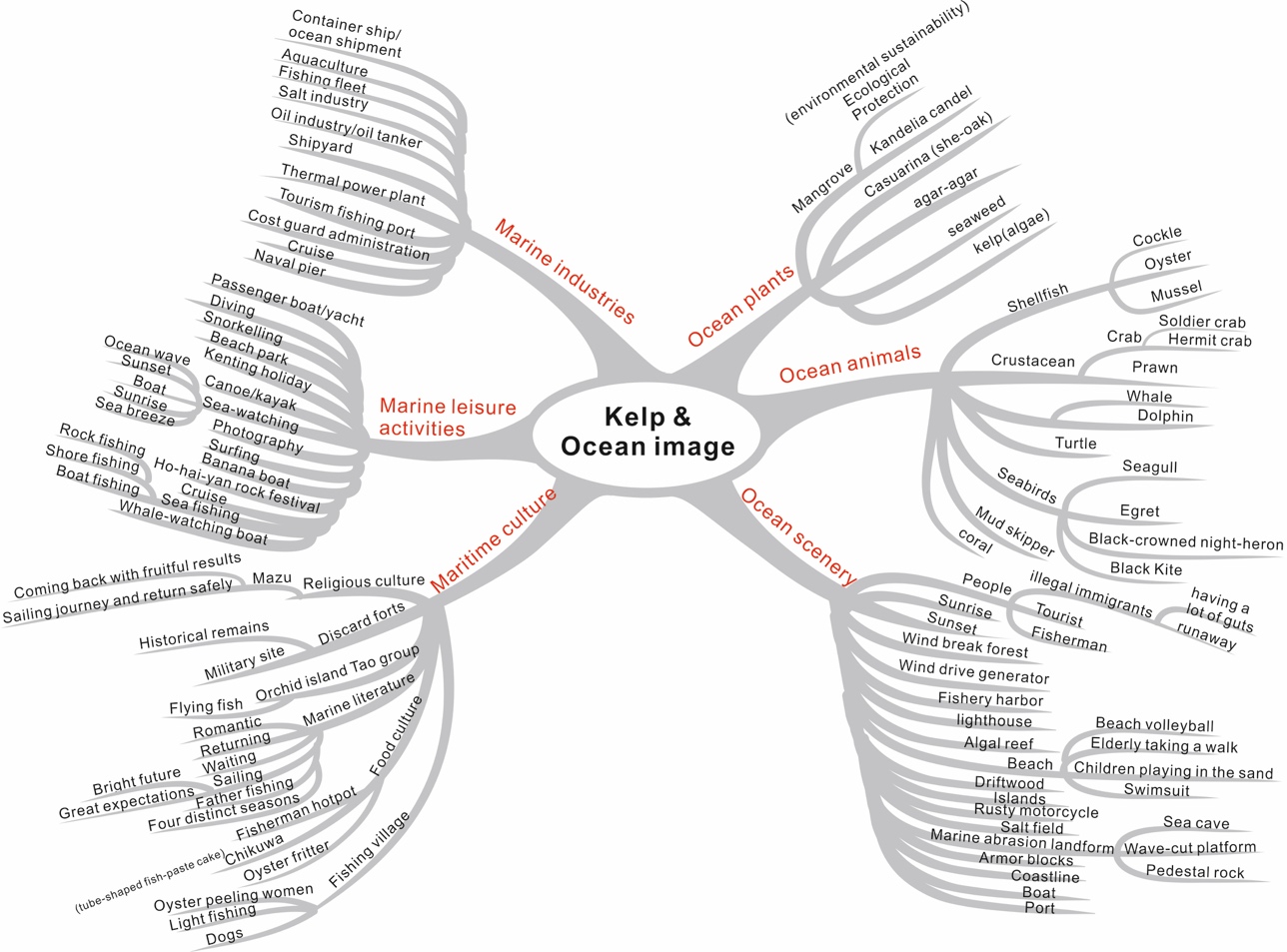
4.2. Concretisation stage: defining design objectives
In this stage, the emphasis is on convergent thinking, aiming to define design objectives and make the design problem more tangible and explicit using more concrete media. We have chosen to employ the method of image boards to analyse information and present the outcomes of the research and analysis phase. The reasons for choosing image boards are as follows: Firstly, the method of image boards is simple, user-friendly, and highly efficient, allowing us to quickly achieve our objectives. Secondly, the use of image boards can enhance the quality of team decision-making.
During the research and analysis phase of the design process, image boards are commonly used for market positioning and guiding design direction. In this project, we have utilised two different types of image boards:
- Image positioning map: analysing the product from its perspective, providing a visual representation of its features, attributes, and characteristics.
- Mood board: analysing the project from the user's perspective, capturing the desired emotions and experiences associated with the product.
By using image boards, we facilitate effective communication within the design team and ensure a shared understanding of the design objectives and direction. The visual representation of information through image boards serves as a valuable tool for ideation and decision-making.
4.2.1 Utilising an image positioning map to define product value in markets
The Cross-Image Board consists of two axes: the X-axis represents the concepts of femininity/softness and masculinity/hardness, while the Y-axis represents the concepts of complexity and simplicity. These two axes create four quadrants, each representing different meanings in market positioning. In design research, it is common to use two contrasting concepts to analyse the product image and define its value in the market (Lin, 2010). Based on the expectations and product goals described in the previous stages, the design team decides to focus on the area circled in the diagram for concept development (see Figure 13). This indicates a positioning with a simpler and softer appearance. This decision is based on the design team's judgment, and the circled area is considered an important direction for the subsequent development of the product's visual design.
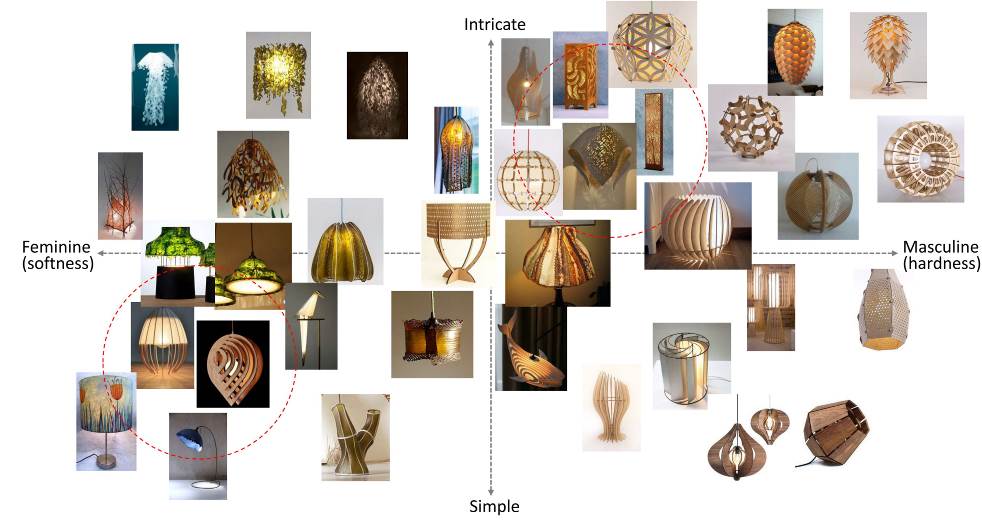
4.2.2 Using a mood board to define the emotional value of products for target consumers
After analysing, organising, and synthesising the various ideas and concepts generated in the previous stages, the design team identified three concepts that are not only emotionally meaningful but also align with the current universal values in Taiwan and are related to the marine imagery. These concepts, namely "hopeful," "sustainable," and "healthy leisure," were deemed suitable as the development direction for this design project.
Taiwanese people value positive thinking and embrace a spirit of challenge. The society promotes the ideals of sustainable development and places significant emphasis on environmental protection. Additionally, there is a strong emphasis on health-oriented leisure activities in daily life. Considering these cultural aspects, the design team created a mood board (see Figure 14) to visually represent these three concepts. The mood board serves as visual references for the design team in the subsequent stage of concept development, facilitating communication and decision-making. The aim is to inspire the design team with more creative and flexible thinking. These three core concepts, which embody positive emotional values, are also the design objectives for the development of this cultural creative product. They aim to establish and convey a positive emotional connection between the users and the product, thus enhancing the overall user experience.
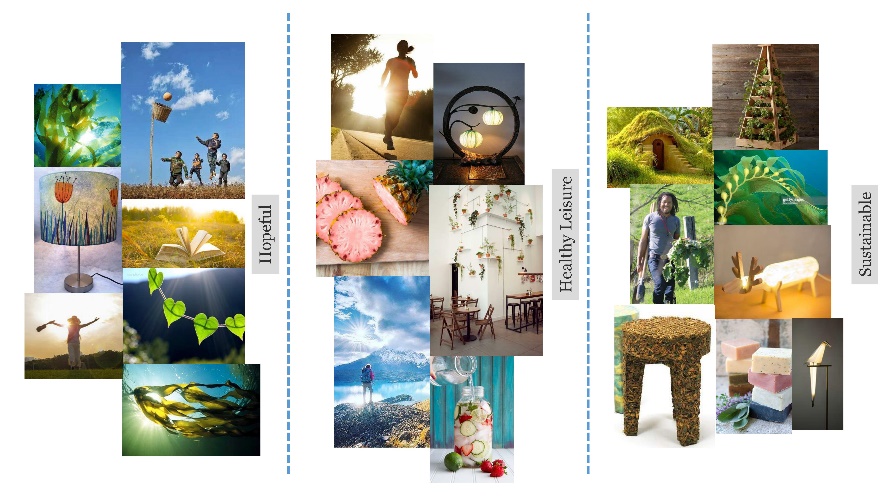
4.3. Transformation: visualising design concepts
During the transformation stage, designers face the complex task of translating abstract ideas into tangible forms and visual representations. This stage requires a delicate balance between divergent and convergent thinking, as designers explore and refine their concepts while staying focused on the project objectives. To bring the design concepts to life, the design team utilises various design representation techniques, such as sketching, or digital rendering. These techniques help visualise the physical appearance of the kelp table lamp based on the established core concepts (see Figure 15). Additionally, the team carefully considers important factors such as the lamp's structural design, the manufacturability of different components, the incorporation of sustainable materials, and the integration of innovative features that enhance the user experience.
An essential aspect of the transformation stage is effectively conveying and presenting the core conceptual ideas. The design team aims to strike a harmonious balance between aesthetics and practicality, ensuring that the final design not only captures the desired visual appeal but also meets functional requirements. Through this meticulous process, the design team lays the groundwork for the subsequent phases of the project, setting the stage for further development, refinement, and the creation of a compelling and sustainable kelp table lamp that resonates with users.
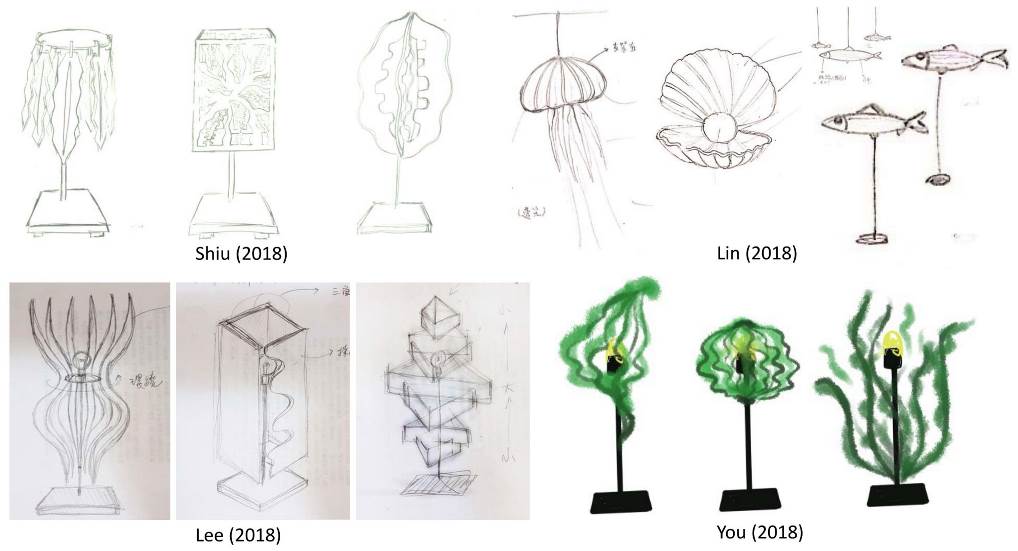
4.4. Implementation: prototyping new product
In this stage, the design process emphasises convergent thinking and is divided into two sub-stages for this project. The first sub-stage focuses on refining details and adjusting the basic structure of the product. 3D Computer software is utilised to simulate the realistic appearance of the product, i.e. rendering (see Figure 16). This simulation serves as the basis for confirming design details, such as the shape, structure, and important dimensions of different product parts. Moving to the second sub-stage, the design team proceeds with the production of physical prototypes. During this process, they verify the feasibility of design details and structural integrity, making necessary adjustments as required. The design team finally selected four kelp table lamps as the project's outcomes (see Figure 17). The final four pieces of the kelp table lamp showcase the following characteristics: 1) The utilisation of kelp as a material to highlight its health-oriented value, 2) Integration of lighting functionality representing positive energy and hope, 3) Combination of kelp with lighting to convey the image of sustainable development, and 4) Elegant and simple exterior design.
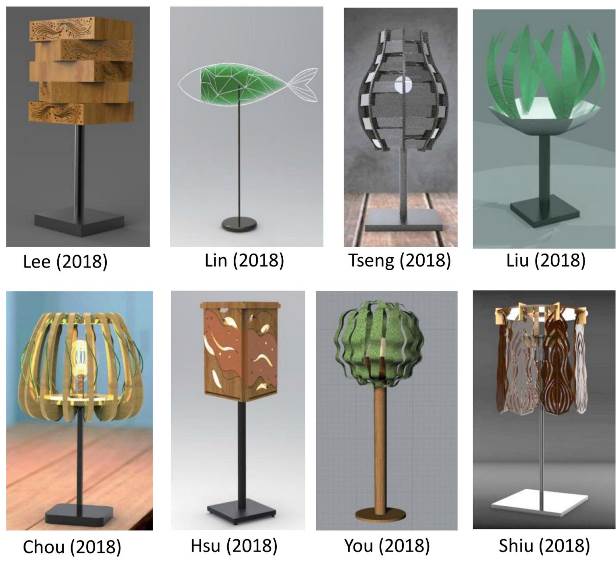

Moreover, the act of switching the light on and off and the metaphorical implications behind it aim to inspire users to reflect on marine conservation. The heat energy emitted by the lamp symbolises the practical function of drying kelp, metaphorically representing the ecological relationship between sunlight and kelp. This aspect serves as a focal point of the design team's emotional design strategy, aiming to establish a connection between users and the ocean and ultimately foster meaningful design innovations that transform the significance of the product. For certain users, the kelp table lamp may transcend its role as a household lighting and decoration item; it could become a symbol of respect and gratitude towards the ocean, a means of engagement with the marine environment, or even serve as a bridge connecting individuals with the sea. Furthermore, these kelp table lamps are exhibited long-term in a small museum located in Taipei for the purpose of public education (see Figure 18). The kelp table lamps created in this project are not just functional lighting products; they are also art installations that convey messages about ocean conservation, aiming to raise awareness and reflection among the public on ocean-related issues.
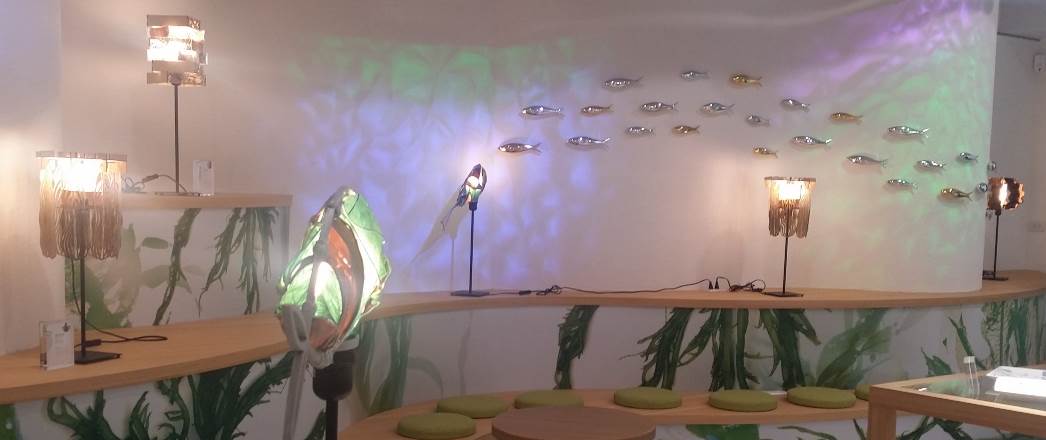
5. Discussion and Conclusions
The cultural creative industries in Taiwan are thriving, and to succeed in both industrial culturalisation and cultural industrialisation strategies (Yang & Chang, 2005), it is essential to focus on cultivating creative design talents and advancing cultural creative design methodologies. With Taiwan being surrounded by the sea, its abundant marine resources have contributed to its prosperity and have played a significant role in shaping the maritime character of its people. The deep-rooted maritime genes in the Taiwanese people make the exploration of marine culture essential and in demand as the foundation for creating distinctive products. Developing cultural creative products with marine imagery goes beyond market strategies; it holds substantial implications for marine education.
In the modern era, consumers increasingly seek products that evoke emotional value and cultural connections because these products create unique meanings and memories. Building products with a sense of connection is based on the stories and concepts they convey, becoming a powerful tool for differentiation strategies in new product development. In this study, we propose a design process model applicable to the development of cultural creative products, using the example of kelp table lamps to demonstrate the process of utilising marine imagery elements in creating cultural creative products. By infusing marine symbolism into the design, we aim to foster meaningful connections between users and Taiwan's oceanic heritage, contributing to the preservation and appreciation of the marine environment through cultural creative expressions.
The design process model proposed in this study is an integration of various established design methodologies. It is based on the image transformation design process model by You et al. (1996), enriched with the key decision points concept from Cooper (2000)'s stage-gate model, and guided by the framework of divergent and convergent thinking from The British Design Council (2006)'s double diamond design process. This model consists of four main stages: Association, Concretisation, Transformation, and Implementation.
During the Association and Transformation stages, divergent thinking takes centre stage as the design team explores innovative opportunities and generates creative solutions. As the process progresses into the Concretisation and Implementation stages, convergent thinking becomes pivotal for effective decision-making and problem-solving. However, it is important to note that thinking styles in the process are not strictly confined to divergent or convergent modes but often complement each other. By intertwining divergent and convergent thinking, participants are encouraged to approach problems from different angles, leading to fresh insights and creative inspirations.
The foundational framework of the image transformation design process model serves as a robust platform for translating abstract concepts into tangible forms, enabling the creation of culturally rich and meaningful symbolic representations and design elements. This imbues the product with profound meaning and establishes an emotional connection between the user and the ocean, which can potentially lead to significant design innovations. Additionally, the concept of key decision points promotes real-time review and efficient decision-making, driven by cognitive demand pressure (Mao & Cheng, 2009). By operating within the logical framework of the image transformation design process model, and incorporating the concept of key decision points, participants are empowered to make effective design decisions, reducing the need for repetitive revisions in previous stages. Moreover, novice designers involved in the process can easily identify and utilise appropriate design methods and tools at each stage, fostering a more seamless and productive experience within this cultural creative product design model.
The design model proposed in this study is not a panacea for the development of cultural and creative products. It is designed for users who possess a foundation of design skills for developing such products. When adopting this design model, it is advisable to establish a design management organisational structure, with at least one manager overseeing and coordinating the project's stage tasks. Individuals, based on their understanding of the design process model and self-management of the design flow, can also achieve the aforementioned effectiveness (Lee, 2015). However, due to limitations in time and funding, this study only involved second-year students from National Taiwan Ocean University, with the teacher serving as the project manager. Therefore, the individual effectiveness of adopting this design model is beyond the scope of this paper. The aim of this study is to stimulate further research by scholars in related fields, providing references for designers and the industry in practical design.
6. References
- Abernathy, W. J., Utterback, J. M., 1978. Patterns of innovation in industry. Technology Review. 80(7): 40-47.
- Barrena, R., Sanchez, M., 2009. Connecting product attributes with emotional benefits: analysis of a Mediterranean product across consumer age segments. British Food Journal. 111(2): 120-137.
- Bennett, C., Ryall, J., Spalteholz, L., Gooch, A., 2007. The Aesthetics of Graph Visualization. In: Cunningham, D. W., Meyer, G., Neumann, L. (Eds.), Proceeding of the Third Eurographics conference on Computational Aesthetics in Graphics, Visualization, and Imaging. pp. 57-64.
- Berends, H., Reymen, I., Stultiens, R. G. L., Peutz, M., 2010. External designers in product design processes of small manufacturing firms. Design Studies. 32(1): 86–108.
- British Design Council., 2006. The design process. London: British Design Council. Retrieved from www.designcouncil.org.uk
- Chen, C. C., Chen, B. C., 2014. The industrialization model study of cultural creative product design and development. Journal of science and technology. 23(1): 11-24.
- Chen, C. C., Lee, J. L., 2008. The Application of Kano Model on Exploring the Attractive Attributes of Cultural Product Design. Journal of Design.13(4): 25-41.
- Chen, S. J., Hsu, C. H., Lin, C. L., 2012. The Transformation of Song Ci Poetry Image in Qualia Product Design. National Taiwan University of Arts. (19): 99–117。
- Chen, Y. Y., 2017. Applying Consumption Value Theory to Analysis Cultural Merchandise Design in Blossom Case. Chung Yuan Christian University.
- Chiou, Y. S., 2017. Cultural creative products need stories. Retrieved from https://read01.com/zh-tw/77RmkN.html#.W0t0L9IzY2
- Chou, T. H., 2018. Kelp table product design project, National Ocean University.
- Chuang, Y. L., 2018, The Branding of Local Specialty Industry on Keelung Heping Island. Journal of Marine and Island Cultures. 7: 170-185.
- Desmet, P., Overbeeke, K., Tax, S., 2001. Designing products with added emotional value: Development and appllcation of an approach for research through design. The design journal. 4(1): 32-47.
- Dickson, P. R., 1997. Marketing Management, Second ed. The Dryden Press, Harcourt Brace College Publishers, Florida.
- Dundon, E., 2002. The Seeds of Innovation: Cultivating the Synergy That Fosters New Ideas. AMACOM, New York.
- Fan, S. H., 2004. A Research on Design Method for transforming image into Idea of Styling. National Cheng Kung University.
- Frayling, C., 1994. Research in Art and Design, Royal College of Art Research Papers. 1(1): 1-5.
- Future Living Lab, 2021. What is an algal reef? In a second, let's help you understand the relationship between Taoyuan Datan algal reef and CPC Corporation. Retrieved from https://www.lifeaholic.tw/article51894/
- Gaynor, G. H., 2002. Innovation by Design: What It Takes to Keep Your Company on the Cutting Edge. AMACOM, New York.
- Gebauer, H., Gustafsson, A., Witell, L., 2011. Competitive advantage through service differentiation by manufacturing companies. Journal of Business Research. 64(12): 1270-1280.
- Hajesfandiari, B., Mehrdad, A. G., Karimi, L., 2014. Comparing the effects of convergent and divergent teaching methods on using articles by Iranian EFL learners. International Journal of Educational Investigations. 1(1): 313-327.
- HMSO, 1995. COMPETITIVENESS: Forging Ahead. Retrieved from http://webarchive.nationalarchives.gov.uk/20140131031506/http://www.archive.official-documents.co.uk/document/dti/dti-comp/dti-comp.htm
- Hsiao, Y. T., 2016. The Application of Plant Imagery to Product’s Form Design. National Taiwan Normal University.
- Hsu, C. H., Lin, R. T., 2011. A Study on Cultural Product Design Process. Journal of Design. 16(4): 1–17.
- Hsu, H. T., 2018. . National Ocean University.
- Hsu, Y. L., 2005. A Study on the Culture Product Feature Transformed from Thematic Image. National Cheng Kung University.
- Kamil, M. J. M., Abidin, S. Z., 2013. Unconscious human behavior at visceral level of emotional design. Procedia-Social and Behavioral Sciences. 105: 149-161.
- Kang, X., Nagasawa, S. Y., 2023. Integrating kansei engineering and interactive genetic algorithm in jiangxi red cultural and creative product design. Journal of Intelligent & Fuzzy Systems. 1-14.
- Kurtoglu, T., Swantner, A., Campbell, M. I., 2010. Automating the conceptual design process: “from black-box to component selection”. Artificial Intelligence for Engineering Design. Analysis and Manufacturing. 24(1): 49–62.
- Lee, J., 2009. Garlicky Seaweed Knots. Retrieved from https://www.foodmayhem.com/2009/08/garlicky-seaweed-knots.html
- Lee, S. F., 2018. Kelp table product design project. National Ocean University.
- Lee, Y. C., Lin, C. Y., 2020. Developing a Design Process Model for Cultural Creative Product a Case Study of Table Lamp. In: Evans, M., Shaw, A., Na, J. (Eds.), Design revolutions: IASDR 2019 Conference Proceedings. Volume 1: Change, Voices, Open. pp.109-121. Manchester Metropolitan University, Manchester.
- Lee, Y. C., 2015. Investigation of Design Decision Making in New Product Development in SME. Lancaster University.
- Lee, Y. C., 2018. Analyzing and applying image of ocean to cultural creative product: kelp as example. The 6th East Asian Island and Ocean Forum 2018: The Commonality of maritime Culture, Guangdong, China. Guangdong Ocean University.
- Lee, Y. C., 2022. From imagination to identification: A co-creation design model based on sense of place. Oceanic Culture Journal. 33: 73-106.
- Lam, C. Y., 2018. Social observation from incident of Taoyuan Guanxin algal reef algae reef. Alley sociology. Retrieved from https://twstreetcorner.org/author/tsasociology/
- Lin, H. Y., 2018. Kelp table product design project. National Ocean University.
- Lin, M. C., 2015. Visual Images Analysis of Paiwan Ancient Pot Symbols Applied to Fashion Fabric Pattern Design. National Pingtung University of Science and Technology.
- Liu, J. H., He, M. C., Yang, Y. F., Lee, C. F., 2006. Research on Culture Code Deployment in Product Design. The Journal of Design Research. (6):140-146
- Liu, T. Y., 2018. Kelp table product design project. National Ocean University.
- Liu, Y. D., 2010. Integrating "Aesthetics of Life "into Contemporary "Environmental Aesthetics". Applied Ethics Review. 49: 73-86.
- Mao, J. G., Cheng, H. C., 2009. A Review and Proposition on the Conceptual Framework of Management Decision. Journal of Management & Systems. 16(2): 131-155.
- Norman, D. A., 2004. Emotional Design: Why We Love (or Hate) Everyday Things. Basic Books, New York.
- Rampino, L., 2011. The Innovation Pyramid: A Categorization of the Innovation Phenomenon in the Product-design Field. International Journal of Design. 5(1): 3–16.
- Reimann, R., 2005. Personas, goals, and emotional design. Retrieved from https://www.uxmatters.com/mt/archives/2005/11/personas-goals-and-emotional-design.php
- Schneider, B., 2007. Design as Practice, Science and Research. In: Michel, R. (Eds.), Design Research Now. Birkhäuser, Basel, pp. 207-218.
- Sharp, B., Dawes, J., 2001. What is differentiation and how does it work?. Journal of Marketing Management. 17(7-8): 739-759.
- Shiu, K. S., 2018. Kelp table product design project. National Ocean University.
- Suen, Y. H., 2008. Discusses the emotional design from the life
- aesthetics: the porcelain tea set design as the explanations. National Taiwan Normal University。
- Tan, R., 2019. 6 Most Common Varieties of Edible Seaweed. Retrieved from https://guide.michelin.com/tw/en/article/dining-in/6-edible-delicious-varieties-of-seaweed
- Trott, P., 2005. Innovation Management and New Product Development, Third ed. Pearson Education, Essex.
- Tseng, W. T., 2018. Kelp table product design project. National Ocean University.
- Tung, F. W. (2011) Legends as Sources of Inspiration: Product Design inspired by the Legend of “the Dragon’s Nine Sons”, Journal of Design, 16(4), 75-90.
- Verganti, R., 2008. Design, Meanings, and Radical Innovation: A Metamodel and a Research Agenda. Journal of Product Innovation Management. 25(5): 436–456.
- Vogel, C. M., Cagan, J., Boatwright, P., 2005. The Design of Things to Come: How Ordinary People Create Extraordinary Products. Wharton School Publishing, New Jersey.
- Wang, H. S., Hung, R. L., 2011. A Metaphorical Method for Product Design in Cultural and Creative Industry. Journal of Design. 16(4): 35-55.
- Wang, Y. C., Chiou, S. C., 2019. Creation and analysis of Tamsui three-dimensional model using biological genetic concept design. Journal of Design Studies. 4(1): 3-18.
- Wei W. L., 2011. Applying Intangible Cultural Codes in Product Design Process-Using Taiwanese Religious Proverbs of South Min as an example. Journal of Design. 16(3): 69–93.
- Yang, M. W., Chang, Y. M., 2005. A Study on the Consciousness of Industry Cultural Activities and Package Design of Agricultural/Special Products - Survey Evidence from Zo-Chen Chalk Festival. Journal of Design Studies. 10(1): 19-42.
- You, M. L., Yeh, P. H., Kao, Y. C., 1996. A Study on Product Image and Its Representation Design with Radio Design as a Case Study. Journal of Design. 2(1):31-45.
- You, Y. C., 2018. Kelp table product design project. National Ocean University.
- Youth Hope, 2017. Taiwan Unique Fucoidan (Marine Brown Seaweed). Retrieved from https://youth-hope.com.tw/en/unique-fucoidan-marine-brown-seaweed-from-taiwan
- Zhu, W., Han, S., 2022. Cultural Product Appearance Design Based on Improved Multiobjective Optimization Algorithm. Security & Communication Networks. 2022(1): 1-9.
- Zimmerman, J., Forlizzi, J., Evenson, S., 2007. Research through design as a method for interaction design research in HCI. In: Begole, B., Payne, S., Churchill, E., Amant, R. S., Gilmore, D., Rosson, M. B. (Eds.), CHI’07: Proceedings of the SIGCHI conference on Human factors in computing systems. Association for Computing Machinery, New York, pp. 493-502.
